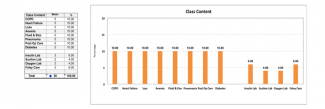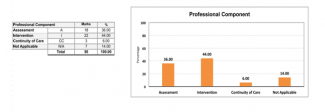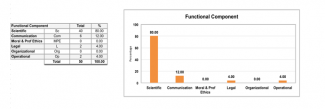An additional benefit of using PASS is its ability to produce a detailed test blueprint. Originally, our test blueprint was a document that outlined the content we were testing and how it was weighted. The PASS Excel grid generates a more detailed blueprint, giving the total number and percentage of questions for each of the categories and variables you have included on the test.
Written tests prepared by teachers are often the primary means of evaluating students' learning. These tests need to be well designed and need to reflect the learning outcomes of the course. A blueprint can assist teachers with the test-preparation process.
In our experience, the blueprints generated by PASS are a tool that promotes teacher discussion about our tests and test questions. It is the basis upon which we make changes to our tests, always keeping in mind our ultimate goal: student success on the OIIQ Professional Licensing Exam. By the time students complete a nursing program, they should be taking tests that have been designed to mirror the blueprint of the OIIQ Professional Licensing Exam. We have found that it is best to have a program-wide plan for your test blueprints, to provide for a gradual increase in level of difficulty until the students are ready for the complexity of the OIIQ exam.
As the blueprint for the OIIQ Professional Licensing Exam does evolve over time, we suggest that you maintain regular contact with the OIIQ so that you have access to the most up-to-date blueprint information.
Benefits of having a blueprint for your test
The blueprint helps teachers by:
- producing a snapshot summary of the test
- ensuring that the test does what it is supposed to do: evaluate the students' learning at the level at which we expect them to perform
- providing direction for making changes to the next test; for example, if you were aiming to have 40% Intervention-type questions but have only 25%, you will make changes to the next test so that it includes more Intervention-type questions
Depending on how you choose to use the test blueprint with students, it can also provide them with valuable information. Although we have never shared the entire blueprint with students before the test, we do give them a blueprint containing Content, Professional Component and/or Bloom’s Taxonomy. After the test, students can infer the entire content of the blueprint from the Student Performance Assessment Graphs (SPAG).
The blueprint helps students by:
- informing them of the content that will be tested and the percentage of marks for each topic
- informing them of the percentage of marks for each question level in Bloom's Taxonomy, because it will affect how they prepare for the test (Oermann & Gaberson, 2017, p. 53); for example, students should prepare differently for Remember- and Understand-level questions as compared to Apply- and Analyze-level questions
- acting as a contract between teachers and students; in other words, students can be confident that the teachers will test only what they say they will test
Here is an example of a test blueprint from a third-semester Medicine & Surgery course:
Test Blueprint




PASS can produce a similar blueprint for any test. In our program, we attach the blueprint to all of our Teacher Answer Guides. This way, we can make any required changes before we administer the test again.